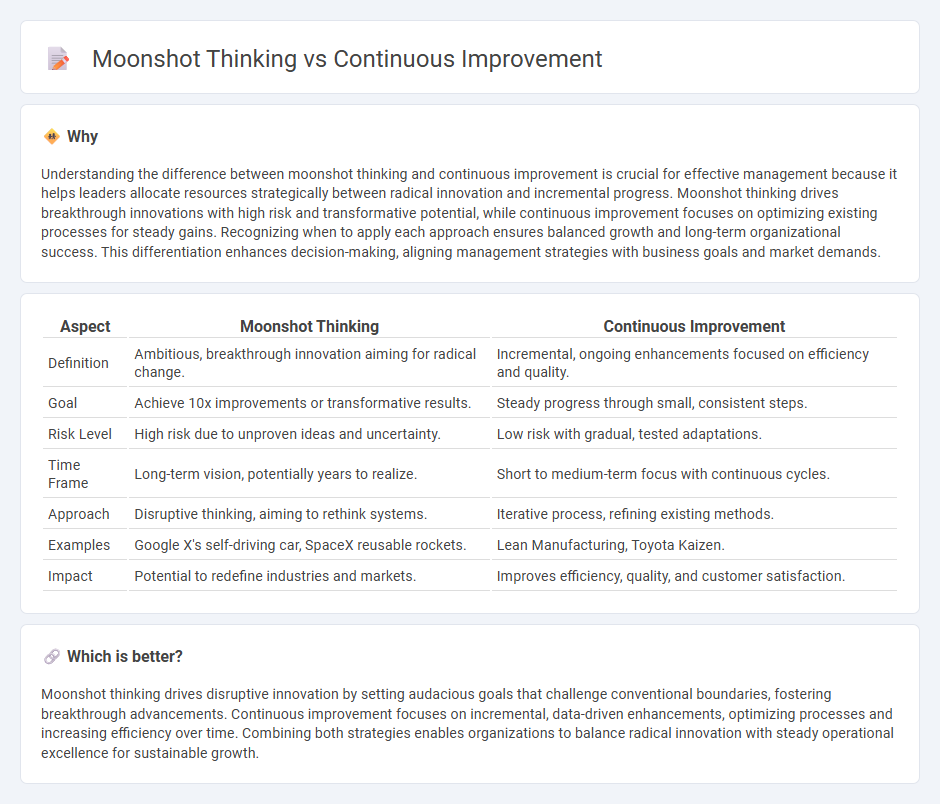
Moonshot thinking drives radical innovation by targeting breakthrough goals that redefine industries, while continuous improvement focuses on incremental advances to enhance existing processes and efficiency. Organizations balancing both approaches foster a culture of transformative ideas alongside steady progress to maintain competitive advantage. Explore how integrating moonshot thinking with continuous improvement can accelerate your business growth and innovation.
Why it is important
Understanding the difference between moonshot thinking and continuous improvement is crucial for effective management because it helps leaders allocate resources strategically between radical innovation and incremental progress. Moonshot thinking drives breakthrough innovations with high risk and transformative potential, while continuous improvement focuses on optimizing existing processes for steady gains. Recognizing when to apply each approach ensures balanced growth and long-term organizational success. This differentiation enhances decision-making, aligning management strategies with business goals and market demands.
Comparison Table
| Aspect | Moonshot Thinking | Continuous Improvement |
|---|---|---|
| Definition | Ambitious, breakthrough innovation aiming for radical change. | Incremental, ongoing enhancements focused on efficiency and quality. |
| Goal | Achieve 10x improvements or transformative results. | Steady progress through small, consistent steps. |
| Risk Level | High risk due to unproven ideas and uncertainty. | Low risk with gradual, tested adaptations. |
| Time Frame | Long-term vision, potentially years to realize. | Short to medium-term focus with continuous cycles. |
| Approach | Disruptive thinking, aiming to rethink systems. | Iterative process, refining existing methods. |
| Examples | Google X's self-driving car, SpaceX reusable rockets. | Lean Manufacturing, Toyota Kaizen. |
| Impact | Potential to redefine industries and markets. | Improves efficiency, quality, and customer satisfaction. |
Which is better?
Moonshot thinking drives disruptive innovation by setting audacious goals that challenge conventional boundaries, fostering breakthrough advancements. Continuous improvement focuses on incremental, data-driven enhancements, optimizing processes and increasing efficiency over time. Combining both strategies enables organizations to balance radical innovation with steady operational excellence for sustainable growth.
Connection
Moonshot thinking drives ambitious, groundbreaking goals that challenge conventional limits, while continuous improvement focuses on incremental enhancements to processes and outcomes. Combining these approaches enables organizations to pursue visionary innovations through steady, measurable progress. This synergy fosters a culture where bold aspirations are systematically translated into achievable milestones, enhancing strategic management and long-term success.
Key Terms
Incremental Innovation
Continuous improvement emphasizes incremental innovation by making small, consistent enhancements that optimize processes and products over time. This method reduces risk and fosters steady growth within organizations through measurable progress. Explore further to understand how balancing this approach with moonshot thinking can transform your innovation strategy.
Breakthrough Innovation
Continuous improvement emphasizes incremental advancements through consistent refinement and optimization of existing processes, driving steady growth and efficiency. Moonshot thinking targets breakthrough innovation by pursuing radical, high-risk projects that have the potential to revolutionize industries and create exponential value. Discover how integrating both approaches can maximize innovation impact.
Risk Tolerance
Continuous improvement emphasizes incremental changes with low risk, fostering steady progress through manageable adjustments and constant feedback loops. Moonshot thinking targets breakthrough innovations, accepting higher risk tolerance to achieve transformative results that reshape industries. Explore how balancing risk tolerance between these strategies can optimize innovation outcomes and drive sustainable growth.
Source and External Links
Continual Improvement Process - This process involves ongoing efforts to enhance products, services, or processes through incremental or breakthrough improvements.
Continuous Improvement Model - This model uses the PDCA cycle to continuously evaluate and improve products, services, and processes through incremental or breakthrough changes.
Examples of Continuous Improvement - These include reviewing employee performances, simplifying business processes, and maintaining health and safety standards to enhance organizational efficiency.
 dowidth.com
dowidth.com